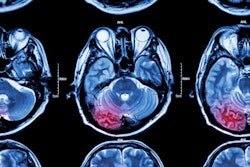Scheduled presenter Steven Mann, PhD, a radiation physicist at Duke University Health System, and colleagues collected data from more than 1,600 diagnostic and interventional cerebral angiography cases using a biplane fluoroscopy system (AlluraXper, Philips Healthcare). Procedures were performed with and without an algorithm designed to suppress image noise around imaging targets to improve contrast-to-noise ratio and reduce radiation exposure for patients.
The researchers recorded the procedure type, dose and utilization metrics, and whether a physician or assistant performed the procedure. They then conducted an analysis of variance (ANOVA) to determine the influence of each variable.
In both diagnostic and interventional procedures, advanced image noise reduction resulted in 73% less dose in targeted areas, with the range of reduction based, in part, on physician and procedure type. The technique did not significantly change diagnostic procedure time for fluoroscopy, but it did increase the time for interventional cases by 26%.
It is important to quantify how advances in image processing and new image acquisition settings can translate into clinical practice by looking at case outcomes for total exposure, Mann and colleagues concluded in their abstract.


















